 Nick Spark—that’s not his picture at the top of this story— was as calm and matter-of-fact over the phone as he was insistent. He wanted very much to convince me that Murphy’s Law applies to itself.
Nick Spark—that’s not his picture at the top of this story— was as calm and matter-of-fact over the phone as he was insistent. He wanted very much to convince me that Murphy’s Law applies to itself.
“Everybody seems to know what Murphy’s law is,” he said, “but at the same time they don’t know what it means.” In other words, if I could misunderstand Murphy’s Law, I would.
And I did.
Spark arguably knows more about the law’s origins than anyone outside of the small group that was present at its inception. He’s a documentary filmmaker and author of the book A History of Murphy’s Law.
Nevertheless, it was hard to believe him when he said most people don’t know what Murphy’s Law means—even if he’s a fellow U.S.C. film school alum.
Getting Murphy’s Law wrong? That’s like not knowing who’s buried in Grant’s Tomb.
He was charged with building a more accurate sensor. Instead he created what today would be considered the king of all memes.
“The tendency is to view Murphy’s Law as a pessimistic statement, but it’s actually optimistic.” Spark said. “It originated with the notion of trying to predict what’s going to go wrong and then circumvent it.”
To understand where Spark is going, you have to know where he’s been, because Murphy’s Law, which often sounds as if George Carlin ad libbed it during a set in Greenwich Village, didn’t originate with comedians or philosophers. It came out of a far more abstruse environment.
A group of engineers.
Spark’s journey through the origins of Murphy’s Law began at Edwards Air Force Base (in the 1940s it was known as Muroc), a sand-blasted, barren patch of land in California’s Mojave Desert. He was looking into the lives of researcher Dr. John Paul Stapp and his colleague, Northrop project manager George Nichols.
“In the late 1940s, Dr. Stapp, who worked for the U.S. Air Force Aero Medical Laboratory at Wright Field in Ohio, arrived at Muroc to perform a series of physiological tests on how much G force a human could endure,” Spark said.
The Air Force wanted to use the tests to design safer seat harnesses for airplane pilots. At the time, the prevailing wisdom was that anything beyond 20Gs was fatal. So seats and harnesses only protected pilots up to that limit.
Stapp demonstrated the number was closer to 40.
The results were life saving, but getting them flirted with fatality. Stapp allowed himself to be fired across the desert on a rocket sled at speeds approaching 200 miles per hour. At the end of the line, he was brought to a stop—in under two seconds.
It was an experiment with a margin of error as thin as a Depression-era wallet.
Nichols and Stapp were having difficulty obtaining good G-force data, so Stapp turned for help to a West Point graduate and engineer.
And that’s when Spark first encountered the name of Capt. Edward Aloysius Murphy, Jr. That’s his picture up top.
“There really was a Murphy of Murphy’s Law, and it was Captain Ed Murphy,” Spark said of the man who was charged with building a more accurate G-force sensor.
Instead Murphy created what today would be considered the king of all memes.
When Stapp was fired down the track with Murphy’s sensor in place, the results were both disheartening and physically impossible. The sensor registered zero G force.
“The sensor had been assembled incorrectly,” Spark said, “not by Ed Murphy but by his assistant.”
At least that’s what Murphy claimed.
There were two ways Murphy’s assistant could have wired up the sensor, meaning there was a fifty-fifty chance he’d get it right—or not.
“Murphy’s response to the failure,” Spark said, “was something like ‘if that guy could get it wrong, he will.’”
Those present were shocked, but not because Murphy had turned a phrase. Murphy had committed one of the cardinal sins of reliability engineering.
He had shifted the blame to someone else.
“These tests were expensive and they were dangerous and I think Ed Murphy may have been a little full of himself, being a West Point guy, and the engineers didn’t like that too much,” Spark said.
It wasn’t until later, after Murphy returned to Ohio, that Nichols realized what Murphy had said.
“Nichols ended up turning Murphy’s statement into ‘if it can happen it will happen,’” Spark said. Perhaps as an act of revenge, Nichols called it Murphy’s Law.
For Nichols and Murphy that was far from the end of the story.
At the moment, Murphy’s Law was a cute aphorism posted on an office wall. What happened when it escaped into the wild demonstrated, once again, that you’re never fully prepared for what can go wrong.
That tale in Part II.
Start your Sunday with a laugh. Read the Sunday Funnies, fresh humor from The Out Of My Mind Blog. Subscribe now and you'll never miss a post.
Nick Spark is a Los Angeles based writer and documentarian with a long standing passion for unconventional characters, including the oft-overlooked female heroine. His new film Right Footed profiles Jessica Cox, who was born without arms but managed to become an airplane pilot and disability rights advocate. The Legend of Pancho Barnes, which he produced and wrote, won him the Los Angeles area Emmy in 2010 for its profile of the gender-bending pilot Florence “Pancho” Barnes, a forgotten rival of Amelia Earhart’s. An accomplished writer of non-fiction and history, Spark was the associate editor for Wings and Airpower magazin
Mind Doodle…
It makes little difference whether Murphy’s Law was discovered by Ed Murphy, George Nichols, Dr. John Stapp, or Jerry Lewis. According to Harold Faber, a former editorial director for the New York Times, its discovery was inevitable under Faber’s First Law: If there isn’t a law, there will be.

One of your very best pieces Jay, funny and educational and maybe even enlightening. Really looking forward to the next installment.
Hi Nick…
Thank you. I’ve wanted to do this story for months. I’m lucky to have found Nick Spark who, in turn, was fortunate to have talked to many of the people involved. I was trained as an engineer, so much of the behavior he described seemed perfectly normal to me—the fascination with sayings; posting them on the wall; looking for places a system will fail. I realize, though, that to “civilians” some of it might seem a little unusual, especially today when so many systems are built with software instead of wires, gears, and lots of moving parts.
Part II deals with what happened once Murphy’s Law got out of Edwards AFB and into the real world 🙂
— jay